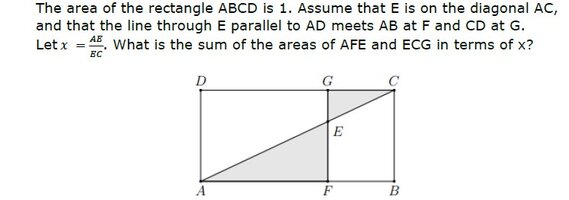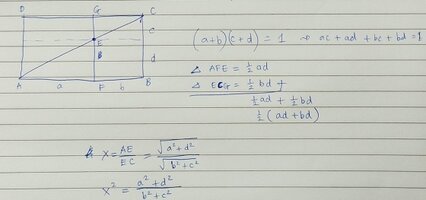You are using an out of date browser. It may not display this or other websites correctly.
You should upgrade or use an alternative browser.
You should upgrade or use an alternative browser.
Sum of shaded areas: The area of a rectangle ABCD is 1. Assume E is on the diagonal AC...
- Thread starter nanase
- Start date
If the ratio of AE:EC is x:1, then similar triangles tell us that the ratio of FE:EG is also x:1. Likewise, the ratio of AF:GC is also x:1.
The diagonal AC, the vertical side BC=FG, and the horizontal side DC=AB can be divided into [imath]\displaystyle\frac{x}{x+1}[/imath] and [imath]\displaystyle\frac{1}{x+1}[/imath] proportional parts.
Let the rectangle's vertical side BC=FG be [imath]l[/imath]. Since the rectangle's area is 1, then the horizontal side DC=AB must be [imath]\displaystyle\frac{1}{l}[/imath]
Break the vertical and horizontal sides down into their proportional parts:
AF must be [imath]\displaystyle\frac{x}{x+1}\cdot\frac{1}{l}[/imath]
GC must be [imath]\displaystyle\frac{1}{x+1}\cdot\frac{1}{l}[/imath]
FE must be [imath]\displaystyle\frac{x}{x+1}\cdot l[/imath]
EG must be [imath]\displaystyle\frac{1}{x+1}\cdot l[/imath]
Now you have the perpendicular legs of both shaded triangles. Add up their areas. The [imath]l[/imath]'s cancel, and you're left with an expression in [imath]x[/imath]
The diagonal AC, the vertical side BC=FG, and the horizontal side DC=AB can be divided into [imath]\displaystyle\frac{x}{x+1}[/imath] and [imath]\displaystyle\frac{1}{x+1}[/imath] proportional parts.
Let the rectangle's vertical side BC=FG be [imath]l[/imath]. Since the rectangle's area is 1, then the horizontal side DC=AB must be [imath]\displaystyle\frac{1}{l}[/imath]
Break the vertical and horizontal sides down into their proportional parts:
AF must be [imath]\displaystyle\frac{x}{x+1}\cdot\frac{1}{l}[/imath]
GC must be [imath]\displaystyle\frac{1}{x+1}\cdot\frac{1}{l}[/imath]
FE must be [imath]\displaystyle\frac{x}{x+1}\cdot l[/imath]
EG must be [imath]\displaystyle\frac{1}{x+1}\cdot l[/imath]
Now you have the perpendicular legs of both shaded triangles. Add up their areas. The [imath]l[/imath]'s cancel, and you're left with an expression in [imath]x[/imath]
Ah yes I missed on using similarity concept, Thank you for giving me the sides, now I can find the areas of each triangle.If the ratio of AE:EC is x:1, then similar triangles tell us that the ratio of FE:EG is also x:1. Likewise, the ratio of AF:GC is also x:1.
The diagonal AC, the vertical side BC=FG, and the horizontal side DC=AB can be divided into [imath]\displaystyle\frac{x}{x+1}[/imath] and [imath]\displaystyle\frac{1}{x+1}[/imath] proportional parts.
Let the rectangle's vertical side BC=FG be [imath]l[/imath]. Since the rectangle's area is 1, then the horizontal side DC=AB must be [imath]\displaystyle\frac{1}{l}[/imath]
Break the vertical and horizontal sides down into their proportional parts:
AF must be [imath]\displaystyle\frac{x}{x+1}\cdot\frac{1}{l}[/imath]
GC must be [imath]\displaystyle\frac{1}{x+1}\cdot\frac{1}{l}[/imath]
FE must be [imath]\displaystyle\frac{x}{x+1}\cdot l[/imath]
EG must be [imath]\displaystyle\frac{1}{x+1}\cdot l[/imath]
Now you have the perpendicular legs of both shaded triangles. Add up their areas. The [imath]l[/imath]'s cancel, and you're left with an expression in [imath]x[/imath]
But I am curious in how you obtain those sides so I dig on the similarity ratios and got this [imath]\frac{AE}{EC}=\frac{FE}{EG}=\frac{AF}{GC} [/imath] . It seems you use different ratios to obtain the sides.
Thank you so much, after much scribbling and working backward from your expression I got the idea how the comparison of sides is made to obtain the expression for the base and height of each triangle.
It seems you are using
[imath]\frac{AF}{AE}=\frac{DC}{AC} [/imath]
[imath]\frac{GC}{EC}=\frac{DC}{AC} [/imath]
[imath]\frac{FE}{AE}=\frac{CB}{AC} [/imath]
[imath]\frac{EG}{AC}=\frac{DA}{AC} [/imath]
I fail to see and make ratios from those, but now I see it can be done. Thank you!


